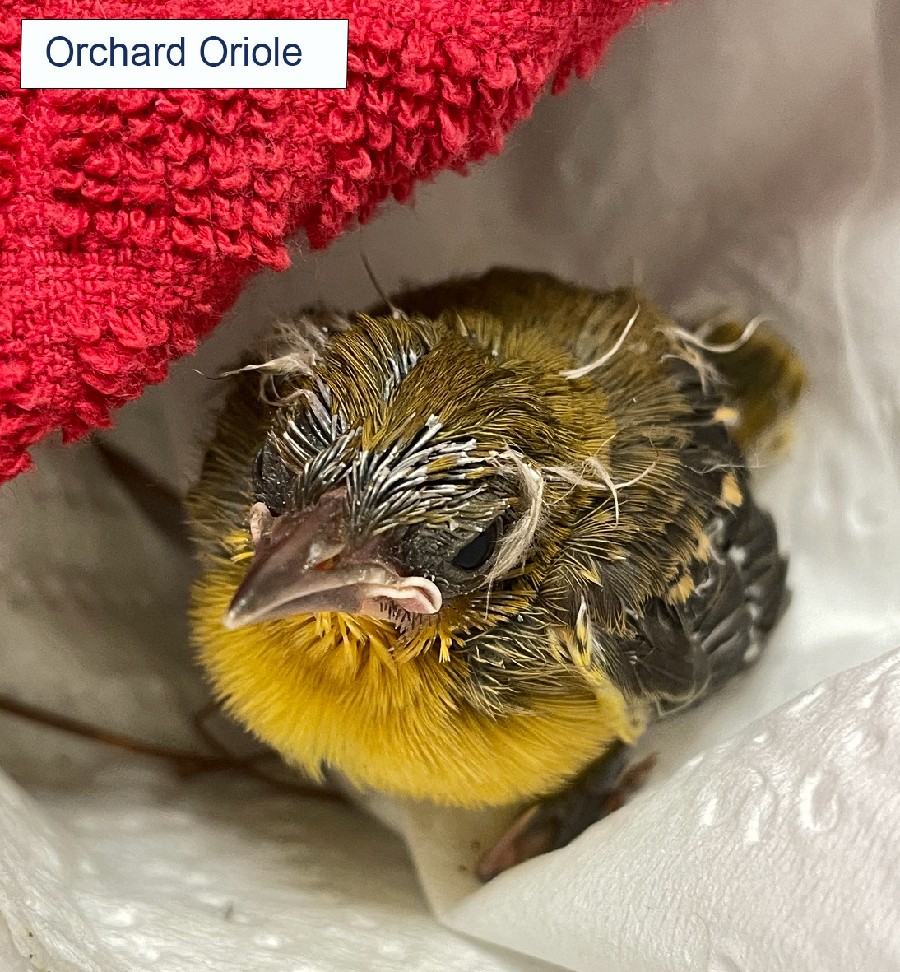Orchard Oriole
Icterus spuriusThe Orchard Oriole is the smallest North American oriole and might even be mistaken for a warbler at first glance. The male is a rich chestnut-brown and black, but in poor light can appear almost all black.
This bird breeds in open land with scattered trees such as orchards, parks, and residential areas, and has a preference for areas along lakes and streams. The Orchard Oriole arrives in Tennessee in mid-April and is among the first migrants to depart at the end of the breeding season in July.
The breeding range extends across most of the eastern United States east of the Rocky Mountains, and the winter range reaches from southern Mexico to northwestern South America.
Description: The male and female look very different. The adult male is a rich chestnut-brown with a black hood, back and tail, and black wings with one thin white wing bar. The female is olive-yellow above, and brighter below with duller wings that have two white wing bars.
First-year males (February-August) are yellow like the female, but have a black throat patch and occasionally some chestnut feathers on the body. Males do not reach adult plumage until their second fall.
Length: 7.25"
Wingspan: 9.5"
Weight: 0.67 oz
Voice: The song is a lively series of sliding warbled notes, often ending with slurred zheer or whee. Call note is a soft chuck or a dry chatter.
Similar Species:
- The Baltimore Oriole male is similarly patterned, but is bright orange and has an orange tail. The female and immature male are light oranges not olive-yellow.
Habitat: The Orchard Oriole nests in gardens, orchards, scattered trees in pastures, and residential areas, often near streams and lakes.
Diet: Insects, spiders, nectar, and fruit.
Nesting and reproduction: Egg laying peaks in late May in Tennessee and only one brood is raised per season. Adults and young begin to migrate south in early July.
Clutch Size: The range is from 3 to 7 eggs, with 4 to 5 eggs most common.
Incubation: The female alone incubates the eggs for 12 to 15 days.
Fledging: Both adults feed the young, which leave the nest in 11 to14 days.
Nest: The female weaves the open cup-nest from grasses, and lines it with fine grass, plant down, and feathers. It is usually suspended in the fork of a tree branch far out from the trunk. Tennessee nests range in height from 6 to 49 feet above the ground. The average nest height is 19 feet.
Status in Tennessee: The Orchard Oriole is a fairly common summer resident across Tennessee. It is present in the state from mid-April and departs from early July to late August. The population in Tennessee, as well as range-wide, is declining.
Fun Facts:
- Orchard Orioles are known to nest in the same tree as Eastern Kingbirds. This pattern has frequently been observed in Tennessee. They may do this to benefit from the Eastern Kingbird's legendary aggressiveness toward potential predators.
- Young male Orchard Orioles do not achieve adult plumage until the fall of their second year. However, some first-year males with female-like plumage succeed in attracting a mate and nesting successfully.
- Only loosely territorial, the Orchard Oriole is often described as "semi-colonial" in areas of prime habitat, but it is generally solitary in most habitats. More than one nest may be found in the same tree in areas of dense numbers of nesting Orchard Orioles.
- Southeastern Louisiana seems to be the heart of this oriole's nesting range since the highest densities have been recorded there. At one locality there were nearly 20 nests in a single live oak, and at another locality 114 nests were found on a seven-acre tract with 80 oaks.
- The Orchard Oriole regularly eats nectar and pollen from flowers and is an important pollinator for some tropical tree species. It transfers the pollen from flower to flower on its head.
Obsolete English Names: ochre oriole
Best places to see in Tennessee: Orchard Orioles nest in every county in the state in open areas with large shade trees. The best time to find one is when the males are singing from mid-April until early June.

